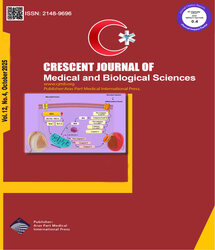

| Original Article | |
| The Correlation Between Pulmonary Hypertension and “Pro-Brain Natriuretic Peptide” Serum Level and the Quantity of Left to Right Shunt (Qp/Qs Ratio) in Children With Congenital Heart Disease | |
| Mahmood Samadi, Ahmad Jameii Khosroshahi, Ali Aghyar Macooie, Elnaz Eskandartash, Shahriar Anvari | |
| Cardiovascular Research Center, Tabriz University of Medical Sciences, Tabriz, Iran | |
|
CJMB 2017; 4: 023-027 Viewed : 5173 times Downloaded : 3839 times. Keywords : Pulmonary arterial hypertension, B-type natriuretic peptide, Congenital heart disease, Left to right shunt |
|
| Full Text(PDF) | Related Articles | |
| Abstract | |
Objective: Pulmonary arterial hypertension (PAH) is a common complication in congenital heart diseases. To evaluate the quantity of the shunt and the systolic pulmonary pressure the serum level of B-type natriuretic peptide (BNP) was investigated. Materials and Methods: In this analytical-descriptive study, 30 infants and children with respiratory distress, recurrent pneumonias, failure to thrive and had a murmur in their physical examinations and a cardiomegaly on the chest x-ray was selected. Patients have one of ventricular septal defect (VSD), atrial septal defect (ASD) or pulmonary duct artery (PDA) in echocardiography. The BNP serum level measured and compared to the quantity of the left to right shunt and systolic pulmonary pressure detected through evaluation of tricuspid regurgitation (TR) by echocardiography. Velocity time integral (VTI) measured by doppler echocardiography at the pulmonary and aortic valves for VSD and ASD, mitral and tricuspid valves for PDA, the Qp/Qs ratio was detected to determine if there was any significant relationship between the former and the two latter. Results: There was a significant relationship between level of pro-BNP and the quantity of the shunt in the patients with VSD, ASD and PDA (P = 0.01). A positive correlation between BNP serum level and Qp/Qs ratio in all the patients. There was significant relationship between pro-BNP level and the systolic pulmonary pressure (P < 0.001). The cut-off point of pro-BNP demonstrating a Qp/Qs ratio more than 1.5 was measured at the level of 36.95 pg/mL, with a sensitivity and specificity of 100% and 83.3%, respectively. Conclusion: In patients whom PAH pressure cannot be measured for any reason, measure BNP serum can be useful. |
Cite By, Google Scholar
Google Scholar
PubMed
Online Submission System
 CJMB ENDNOTE ® Style
CJMB ENDNOTE ® Style
 Tutorials
Tutorials
 Publication Charge
Medical and Biological Research Center
About Journal
Publication Charge
Medical and Biological Research Center
About Journal
Aras Part Medical International Press Editor-in-Chief
Arash Khaki
Deputy Editor
Zafer Akan

















